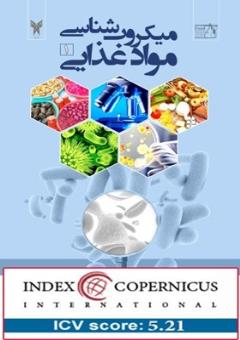Antibiotic resistance pattern in Citrobacter freundii strains isolated from poultry meat in Shahrekord city
Subject Areas : Food Microbial Contamination
Hossein Khodabandeh shahraki
1
,
Elahe Tajbakhsh
2
*
,
Faham Khamesipour
3
,
Hassan Momtaz
4
![]() ,
Manouchehr Momeni-Shahraki
5
,
Manouchehr Momeni-Shahraki
5
![]()
1 -
2 - گروه زیست شناسی دانشگاه آزاد اسلامی واحد شهرکرد
3 -
4 - Department of Microbiology, Shahrekord Branch, Islamic Azad University, Shahrekord, Iran
5 - گروه بهداشت مواد غذایی، دانشکده دامپزشکی، دانشگاه آزاد شهرکرد، ایران.
Keywords: Antibiotic resistance, Citrobacter freundii, poultry meat,
Abstract :
Citrobacter freundi is an emerging foodborne pathogen of public health importance. The present study aimed to investigate the prevalence and phenotypic and genotypic antibiotic resistance of Citrobacter isolates isolated from poultry meat in Shahrekord city. In this cross-sectional-descriptive study, 300 chicken, quail and turkey meat samples were examined for Citrobacter freundi contamination in Shahrekord city in 2024. The samples were examined by biochemical and molecular methods. The disc diffusion method was used to determine the sensitivity of bacteria to antibiotics, and antibiotic resistance genes were examined using specific primers. Using biochemical methods, 24 isolates (8%) of Citrobacter freundi were isolated, which were also confirmed by molecular methods. The contamination was reported to be 12% in quail meat, 7% in chicken meat, and 5% in turkey meat. After confirming the bacteria using microbiological and molecular tests and performing an antibiogram, the highest resistance was reported to co-trimoxazole (70.83%). All strains were sensitive to the antibiotics gentamicin, ceftriaxone, ciprofloxacin, kanamycin, and cefotaxime. The presence of antibiotic resistance in Citrobacter freundii isolates in the present study and similar studies mentioned indicates the use of antibiotics in the treatment of livestock and poultry, which will vary depending on the type of region and the method of antibiotic administration.
[1] Lavigne JP, Defez C, Bouziges N, Mahamat A, Sotto A. Clinical and molecular epidemiology of multidrug-resistant Citrobacter spp. infections in a French university hospital. European Journal of Clinical Microbiology & Infectious Diseases. 2007; 1;26(6):439-41.
[2] Samonis G, Karageorgopoulos DE, Kofteridis DP, Matthaiou DK, Sidiropoulou V, Maraki S, Falagas ME. Citrobacter infections in a general hospital: characteristics and outcomes. European Journal of Clinical Microbiology & infectious diseases. 2009; 1;28(1):61.
[3] Bai L, Xia S, Lan R, Liu L, Ye C, Wang Y, Jin D, Cui Z, Jing H, Xiong Y, Bai X. Isolation and characterization of cytotoxic, aggregative Citrobacter freundii. PLoS One. 2012; 21;7(3):e33054.
[4] Ifeadike CO, Ironkwe OC, Adogu PO, Nnebue CC, Emelumadu OF, Nwabueze SA, Ubajaka CF. Prevalence and pattern of bacteria and intestinal parasites among food handlers in the Federal Capital Territory of Nigeria. Nigerian medical journal: journal of the Nigeria Medical Association. 2012;53(3):166.
[5] Giammanco GM, Aleo A, Guida I, Mammina C. Molecular epidemiological survey of Citrobacter freundii misidentified as Cronobacter spp.(Enterobacter sakazakii) and Enterobacter hormaechei isolated from powdered infant milk formula. Foodborne pathogens and disease. 2011 1;8(4):517-25.
[6] Liu HW, Chang CJ, Hsieh CT. Brain abscess caused by Citrobacter koseri infection in an adult. Neurosciences. 2015; 20(2):170.
[7] Dasenaki M E, Kritikou A S, Thomaidis N S. Meat safety: II Residues and contaminants. Lawrie's meat science.2023; 591-626.
[8] Basra P, Koziol A, Wong A, Carrillo CD. Complete genome sequences of Citrobacter braakii strains GTA-CB01 and GTA-CB04, isolated from ground beef. Genome Announcements. 2015; 26;3(1).
[9] Saba CK, Gonzalez-Zorn B. Microbial food safety in Ghana: a meta-analysis. The Journal of Infection in Developing Countries. 2012; 16;6(12):828-35.
[10] Li Y, Pei X, Zhang X, Wu L, Liu Y, Zhou H, Yang D. 2019. A surveillance of microbiological contamination on raw poultry meat at retail markets in China. Food Control. 104, 99-104.
[11] Namaki F, Rajabi Z, Soltan Dalal M.M. Antimicrobial rasistance pattern of Citrobacter species isolated from food outbreaks. Razi Journal of Medical Siences. 2019; 26 (5): 9-17.
[12] Clinical and Laboratory Standards Institute. M100-S26. Performance standards for antimicrobial susceptibility testing: 26th informational supplement. Wayne, PA: CLSI. 2023.
[13] Santosa C, Ramalheirab E, Da Silvac G, Mendo S. Genetically unrelated multidrug and carbapenem-resistant Citrobacter freundii detected in outpatients admitted to a Portuguese hospital. Journal of Global Antimicrobial Resistance. 2017. 8: 17-22.
[14] Henchion M, McCarthy M, Resconi VC, Troy D. Meat consumption: Trends and quality matters. Meat Science. 2014; 98 (3):561-568.
[15] Giammanco GM, Aleo A, Guida I, Mammina C. Molecular epidemiological survey of Citrobacter freundii misidentified as Cronobacter spp.(Enterobacter sakazakii) and Enterobacter hormaechei isolated from powdered infant milk formula. Foodborne pathogens and disease. 2011 1;8(4):517-25.
[16] Momtaz H, Safarpoor Dehkordi F, Rahimi E, Ezadi H, Arab R., 2013. Incidence of Shiga toxin-producing Escherichia coli serogroups in ruminant's meat. Meat Sci. 2013; 95 (2):381-388.
[17] Pepperell C, Kus JV, Gardam MA, Humar A, Burrows LL. Low-virulence Citrobacter species encode resistance to multiple antimicrobials. Antimicrobial agents and chemotherapy. 2002 Nov 1;46(11):3555-60.
[18] Kanamori H, Yano H, Hirakata Y, Endo S, Arai K, Ogawa M, etal.High prevalence of extended –spectrum b-lactamases and qnr determinants in Citrobacter species from Japan:dissemination of CTX-M-2.J Antimicrob Chemother. 2011:66(10)2255-2262
[19] Zenebe T, Kannan S, Yilma D, Beyene G. Invasive bacterial pathogens and their antibiotic susceptibility patterns in Jimma University specialized hospital, Jimma, Southwest Ethiopia. Ethiopian journal of health sciences. 2011;21(1):1-8.
[20] Qureshi M, Aziz F. Prevalence of microbial isolates in blood cultures and their antimicrobial susceptibility profiles. Biomedica. 2011 Jul;27(2):136-39

